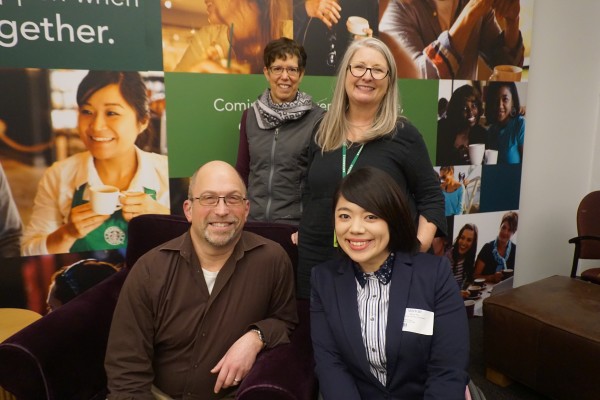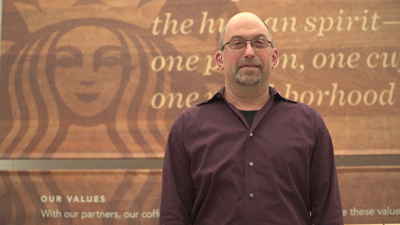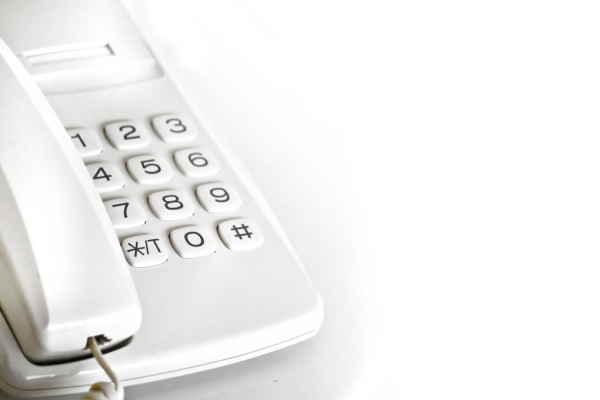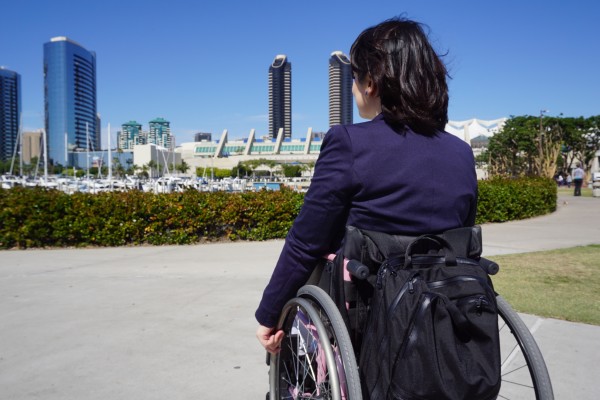この記事は次の言語でも読めます:日本語
*** Part 2 is here ***
In my first report of visiting Starbucks, I wrote about a Deaf Starbucks partner who gave his perspective in the Starbucks Access Alliance (SAA) meeting.
Fortunately, I later got a chance talk with him one on one.
His name is Adam Novsam, Business Analyst and a member of SAA.
He has worked for Starbucks since 2000 and shared his valuable experiences with me.

Adam was born Deaf. He went to a school where the student body was Deaf and everyone signed.
Classes were like a typical school – math, reading, etc. – the students, however, had the benefits of sharing the same language, American Sign Language (ASL), and culture.
Their school community was tight-knit and included Deaf and hearing people.
As a child, that was the whole world Adam knew.
As he grew older, though, his parents wanted to expose Adam to a mainstream public school.
There he learned a lot of the “differences” between Deaf and hearing cultures.
Adam said,
“For example, if a Deaf person meets somebody who [he] hasn’t seen for a long time, it would be a common place for Deaf person to tell another Deaf person ‘My goodness, you gain some weight!’
That is a pretty regular conversation you would have in the Deaf community.
Deaf people are visual and literal communicators, so they will say it when they see it.
Now, when you are in hearing culture, you do not tell a hearing person that he or she gained weight.
It is very different.
Deaf community is a shared collective whereas hearing culture is more independent.
They have two very different approaches of life.”
In the US, after they finished college, many Deaf people choose to become ASL teachers or work for Deaf organizations, often because they feel more comfortable staying within the Deaf community.
But, Adam wanted something different.
He had a goal to succeed as a general businessman and a desire to know about the corporate world.
But it was not an easy transition.
Before Adam joined Starbucks, he worked with some other companies.
At those companies, he often experienced difficulties building good communication with hearing people.
It was tough and he faced oppression, too.
Those companies didn’t really evaluate Adam’s performance equally and did not promote Adam for the contributions he made.
Adam said,
“A lot of higher-ups are white, privileged, and male, and they look at you and think, ‘You need to stay here,” indicating a low-ranking position, “You can keep doing what you’ve been doing all along.’ I got frustrated.”

After Adam started working at Starbucks, very fortunately he had a supervisor who was hard of hearing, and he helped Adam develop his potential.
The supervisor lost his hearing entirely, overnight, while working with Adam.
Therefore, the supervisor knew what it was like to be in both hearing and Deaf cultures.
When Adam got confused by the communication with hearing people, he would ask his supervisor “Why do they do this?” and the supervisor would explain to Adam.
To Adam, his supervisor was the one who helped him gain a better understanding of the hearing world.
As Marthalee explained in the report part 2, Starbucks has put a lot of effort to improve the working environment for people with disabilities.
Adam proves that to me.
He grew up in Deaf culture and now he works primarily with hearing people, sharing knowledge and ideas with his colleagues while working at Starbucks, a truly global company.
Adam says,
“For me, I feel very fortunate that I was able to get my feet in the door at Starbucks.
Also I was able to build my reputation with this company.
Very valuable. I cannot imagine quitting here and going to some other companies.
I would have to start all over again at the bottom.”

In this interview, I also shared my former colleague who was deaf in Tokyo.
She and I were hired as the first few disabled employees in the company in the year.
The company didn’t have any experiences to accommodate employees with disabilities at the time, and their resource was limited as it is a middle size company.
As a Moon Rider, a wheelchair user, accommodation for me is easy as long as the office building is accessible.
I didn’t need any other accommodation. But for the deaf colleague, it was not easy for her and the company.
She couldn’t get an interpreter in meetings.
Her coworker always took notes for her, but it was not the best accommodation because the coworker was also a member of meetings.
Her coworker needed to pay attention to what people talking in meetings, take notes for her, and give opinions or comments, too.

Moreover, in the company, the most common way to contact among employees was giving a call.
Although Human Resource announced to all employees about the deaf colleague after getting her permission, many of the employees forgot and kept giving a call to her.
Of course, she couldn’t pick up, and needed to ask other coworkers to help her.
She got stressed day by day and left the company after 2 years.
She was one of the closest colleague and the only colleague with disability who I knew.
I felt very sad when she quit. 1 year later, I also left the company and worked with 2 public companies afterwards, but I found no deaf workers in the 2 companies.
Even if more people with disabilities want to work equally with everyone else, they cannot stay and work longer if companies lack for understanding and accommodations for people with disabilities.
On the other hand, if companies have good understanding and accommodations, not only people with disabilities but also every employees can and want to stay and work longer for the companies.
In a place where people from different backgrounds get together, there would be many interesting ideas and valuable thoughts.
That influences company’s business and customers like it did to Starbucks.

In Japan, we have a quota (*1) system for hiring people with disabilities.
Because of that, most of employers care and try to hire people with disabilities.
This is a good start. Doors are at least open for people with disabilities. (*2)
Second step will take place inside of the doors: awareness and readiness for accommodations.
If employers put effort hard and long enough to inside of the company, employees would change gradually and good applicants with disabilities and without disabilities would join and stay longer.
The second step will make a huge difference and the time is now!
To be continued.
*1. I have mentioned about the quota system Japan government adopted here at:
*2. The quota system for hiring people with disabilities in Japan has not only positive aspect but also negative aspect. I have shared my experiences of job hunting in Tokyo in this article.
Quotas Aren’t the Best Reason to Hire Disabled People ~Yahoo Part 2~
